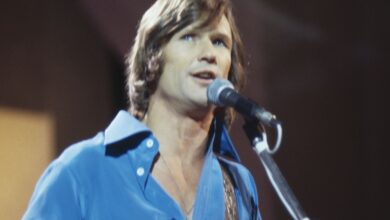The Shangri-Las’ “Leader of the Pack” Transforms Girl Group Narratives and Defines 1964 Rebellion
In 1964, the Shangri-Las unleashed “Leader of the Pack,” a track that would become emblematic of the girl group era and capture the rebellious spirit of youth. This groundbreaking single, with its gritty narrative and unforgettable hook, quickly soared to the top of the charts, becoming one of the defining hits of the mid-sixties and setting a new standard for teen pop ballads.
Originating from New York City, the Shangri-Las were not just any girl group—they were a force of raw energy and unapologetic emotion. Comprised of young women with a distinctively tough yet vulnerable image, they blended heartfelt storytelling with a rock-inflected sound. Their style, marked by husky vocals and dramatic delivery, set them apart in a musical landscape dominated by more polished, mainstream acts.
The inspiration behind “Leader of the Pack” lies in its vivid storytelling—a tale of young love doomed by the allure of a dangerous rebel. Crafted by songwriters Ellie Greenwich, Shadow Morton, and Jeff Barry, the lyrics narrate the bittersweet romance between a devoted girl and a motorcycle gang leader. The song’s narrative, steeped in the angst and passion of youthful defiance, resonated with listeners who saw their own dreams and heartbreaks reflected in its words.
Recorded in a modest studio setting that captured the raw immediacy of the performance, the production of “Leader of the Pack” is as distinctive as its narrative. The track features a driving drumbeat, punctuated by jangling guitars and the unmistakable spoken interlude that added an element of dramatic tension. This stripped-down, no-frills approach allowed the raw emotion of the Shangri-Las’ vocals to shine, underscoring the authenticity of their performance.
Upon its release, “Leader of the Pack” was met with fervent acclaim from both critics and the general public. It quickly ascended the charts, spending several weeks near the top and becoming a crossover hit that appealed to both pop and rock audiences. The song’s success was a testament to its universal appeal—a poignant narrative wrapped in a compelling musical package that captivated listeners from all walks of life.
The cultural impact of “Leader of the Pack” extended far beyond its commercial success. At a time when youth culture was beginning to assert its influence, the song provided a sonic snapshot of teenage rebellion and romance. It bridged the gap between the innocent pop of the early sixties and the edgier rock sounds that would soon dominate the airwaves, influencing both the fashion and attitudes of its generation.
For the Shangri-Las, the success of this track marked a turning point in their career. The hit catapulted them into the national spotlight, earning them television appearances, lucrative tours, and a lasting legacy as icons of a transformative musical era. Their image—equal parts tender vulnerability and fierce determination—captured the imagination of an entire generation, setting the stage for their subsequent endeavors in music and popular culture.
“Leader of the Pack” also left an indelible mark on the music industry, inspiring a slew of artists and bands who sought to capture that same raw, narrative-driven energy. Its influence can be heard in the works of later girl groups and even in the garage rock revival, where the blend of heartfelt storytelling and minimalistic production became a cherished formula. The track’s daring fusion of pop sensibility with rock’s defiant edge paved the way for a more honest, emotive approach in popular music.
Over the decades, numerous artists have paid tribute to the Shangri-Las’ seminal hit. Cover versions by bands from various genres—ranging from punk to indie rock—have reinterpreted the song while preserving its core message of youthful rebellion and heartbreak. Each rendition underscores the timeless quality of the original, proving that its influence extends well beyond the confines of its era.
The release of “Leader of the Pack” coincided with a period of significant cultural and social change in America. Amidst the shifting dynamics of the 1960s, the song became a rallying cry for disaffected youth, capturing the bittersweet complexities of first love and the allure of the outsider. Its narrative of doomed romance and rebellious spirit struck a chord at a time when conventional norms were being questioned and redefined.
In the years since its release, “Leader of the Pack” has maintained its status as a classic. It remains a fixture on oldies radio stations and is a staple of compilations chronicling the golden age of girl groups. The song’s enduring appeal lies in its ability to evoke a sense of nostalgia while continuing to resonate with new generations who find solace in its raw, unvarnished emotion.
Beyond its immediate impact, the track has also played a pivotal role in shaping the future of pop and rock music. Its innovative production techniques—melding simple instrumentation with dynamic storytelling—have influenced countless recordings, setting a precedent for how authenticity and narrative could coexist with commercial appeal. This blueprint has been echoed in the work of many modern artists who strive to capture the same blend of passion and simplicity.
While the Shangri-Las experienced fleeting commercial success after “Leader of the Pack,” the song itself has transcended its era to become a touchstone of 1960s pop culture. Its dramatic flair and narrative depth have earned it a revered place in the pantheon of pop classics, continually celebrated in retrospectives and scholarly discussions about the evolution of popular music.
In reflecting on its legacy, it is clear that “Leader of the Pack” is more than just a hit record—it is a cultural milestone. The track not only encapsulated the zeitgeist of its time but also redefined the role of storytelling in music, influencing generations of artists and listeners alike. Its synthesis of emotion, rebellion, and youthful vulnerability has ensured that it remains a powerful reminder of a transformative moment in musical history.
Ultimately, the enduring appeal of “Leader of the Pack” lies in its capacity to evoke the bittersweet magic of first love and the relentless pulse of youth. It stands as a testament to the raw power of authentic expression—a timeless anthem that continues to inspire and captivate audiences decades after its original release. The Shangri-Las’ landmark hit is a reminder that even in a rapidly changing world, the universal language of music can unite us all through shared stories of love, loss, and rebellion.



